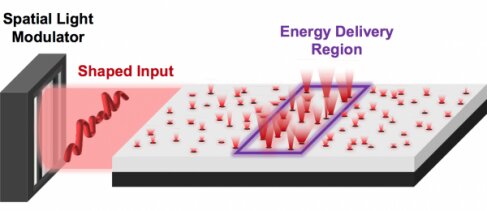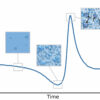In recent years, scientists have been able to transmit light through opaque surfaces, such as white paint or human tissue, which had once been considered impossible. However, a technique for controlled light delivery to a region inside an opaque medium has remained elusive, as well as an understanding of the fundamental limitations.
Researchers in the lab of Hui Cao, the John C. Malone Professor of Applied Physics, Professor of Physics and of Electrical Engineering, find the ultimate limit for energy deposition anywhere inside a diffusive system—that is, material that strongly scatters light and look opaque, such as human tissue. The results are published today in Nature Physics.
Previously, Cao’s team was instrumental in developing methods to pre-treat coherent laser beams so that they can penetrate opaque samples with little reflection. The breakthrough was made possible with advances in optical wavefront shaping. Depositing energy into a target region deep inside an opaque system, such as human tissue, is critical to such potential applications as deep-tissue imaging, optogenetically controlling neurons, and non-invasive ultrasound surgery. One obstacle toward using this technology for a practical application, though, is that researchers don’t know a systematic way of controlling the energy delivered into specific targets inside disordered systems, or the limits of how much energy they can deliver there. For instance, targets such as neurons or early-stage tumors are too large to know the maximum energy that can be delivered.
“We know we can focus light to a point inside a disorder system, but if I wanted to do that over a larger area, it becomes quite challenging,” said Nicholas Bender, the lead author of the study, who was a Yale Ph.D. student in Cao’s lab and is now a postdoctoral researcher at Cornell University. “So we were able to come up with a formalism that enables us to do that. But what was also useful was that we developed a way to predict the ultimate limit on how much light we could get there for an input laser beam of fixed power.”
In their new paper, the researchers developed a theoretical model for predicting the ultimate limit and physical constraints of wavefront shaping. To do so, they used what’s known as filtered random matrix theory. The experimental confirmation was carried out with a unique optical platform that allows for direct measurement of the light field across an entire disordered sample, while simultaneously providing full control over the input wavefront. Many practical applications are far down the road, but this work brings them one step closer and sets the ultimate limit.
“So if you’re trying to deliver energy inside someone’s brain in an application like noninvasive surgery, you would need to use this kind of technique, and you would need to know how much light you can deliver with a given laser,” Bender said.
More information:
Nicholas Bender et al, Depth-targeted energy delivery deep inside scattering media, Nature Physics (2022). DOI: 10.1038/s41567-021-01475-x
Provided by
Yale School of Engineering and Applied Science
Citation:
More control in delivering light to human tissue and other systems (2022, January 28)



